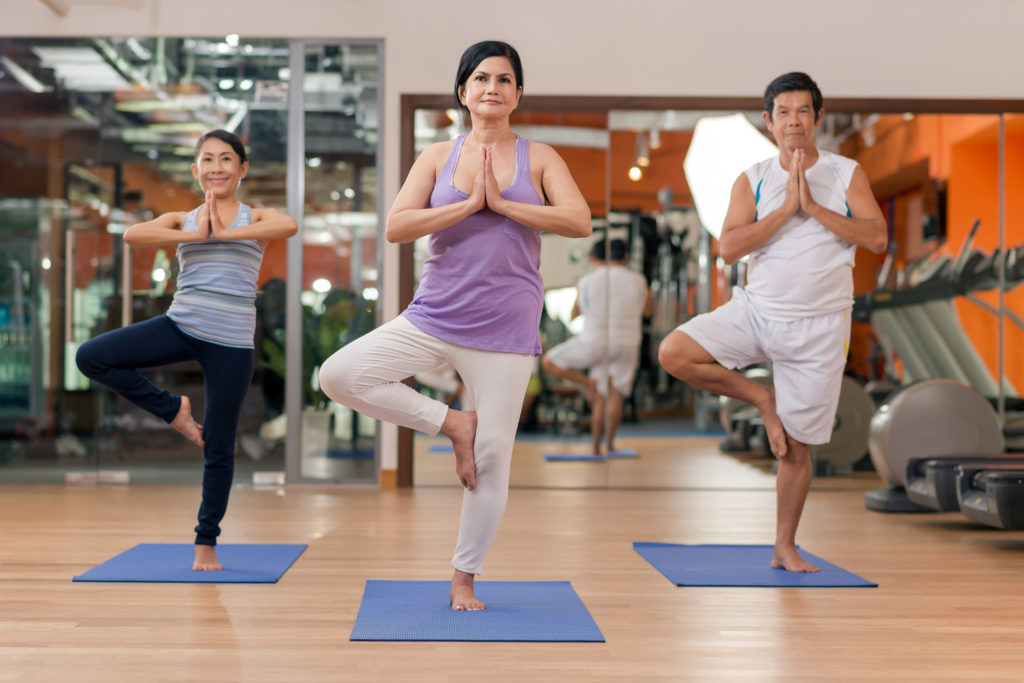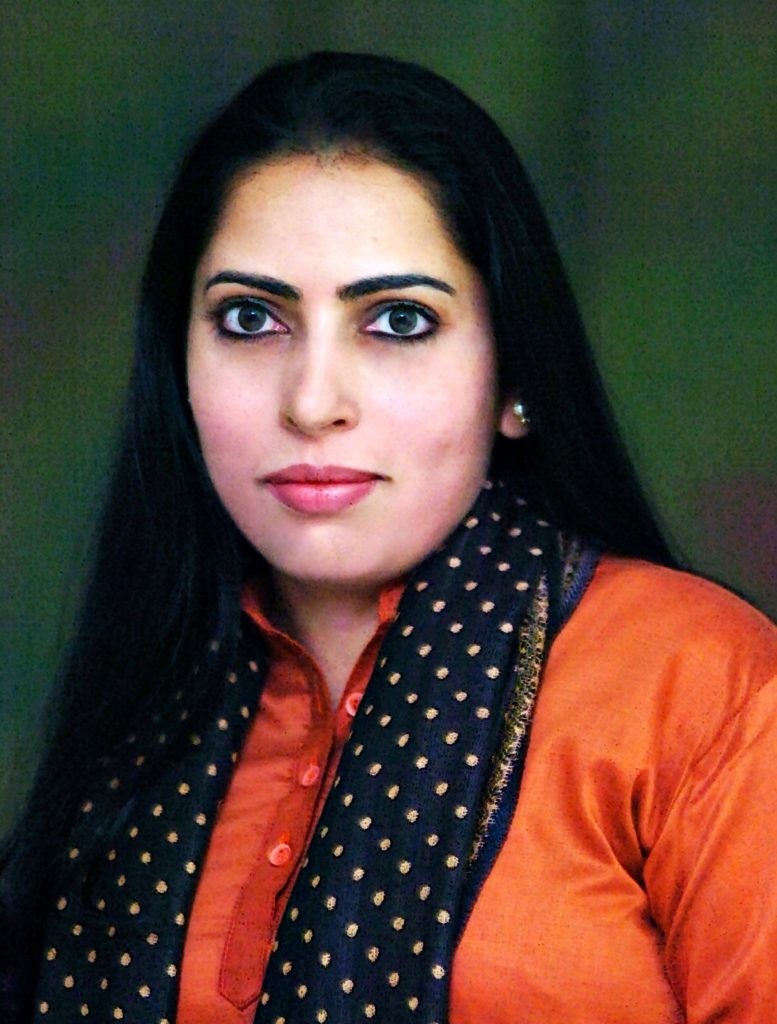
Senior people practicing yoga in the gym
“Aging is not an option, not for anyone. It is how gracefully we handle the process and how lucky we are, as the process handles us.”
Cindy Mcdonald
Getting over the fear of aging:
In a world that is obsessed with beauty and youth, getting older and facing the loss of youth has been often fearful. Aging is usually associated with loneliness, depression, disease, disability, loss of function and death.
The desire to look young is natural. In seeking youthfulness, the search for anti-aging creams, skin treatments, Botox injections and going under the knife for cosmetic surgery begins. According to statistics, in 2018, the global anti-aging market was estimated to be worth about 50.2 billion U.S. dollars. However, the outcome of these procedures is limited to outer appearance with superficial benefits.
Yogic Perspective on Aging:
What if we change our entire perspective on aging? If we adopt a holistic approach of yoga for anti-aging, we can also get a lot more other health benefits. Cosmetic treatments can be compared to spraying water on the flower to make it look fresh, whereas the yoga approach is like nurturing the plant with tender care so that the flower is naturally fresh. The much sought after ‘fountain of youth’ can be found on the yoga mat..!!
Healthy aging is a process of achieving physical, mental and social wellbeing throughout our lives, particularly in the later years. Yoga helps in achieving this goal. Age is not about time, but a state of mind. It’s not just limited to the outward younger appearance, but how we feel inside. Yoga empowers us for positive aging with longevity. We learn to accept aging and enjoy the journey ahead gracefully with confidence. We find a sense of purpose and meaningfulness in life. Yoga also improves the quality of life and overall well-being.
HOW YOGA HELPS IN SLOWING DOWN AGING:
Around the world, research on the anti-aging effects of yoga is carried out. It is claimed that we can ‘block’ or ‘turn off’’ the genetic program called ‘aging’. Although it seems unbelievable, scientific research has already shown the benefits of yoga in preventing age-related degeneration and slowing down the aging process.
Suggested anti-aging mechanisms:
- Cellular level:
Yoga practices reduce the rate of cellular aging and reverse premature aging. Telomeres are the caps at the end of DNA that protect chromosomes. They are like the plastic tips at the end of shoelaces. Longer telomeres are associated with health and longevity.It has been observed that long term meditators have 10 percent longer telomeres than people who never meditate.
- Hormonal Regulation:
DHEA (Dehydroepiandrosterone) is known as the “anti-aging hormone.” As we get older, the production of this hormone slows down. Yoga practices restore and maintain the basal level of growth hormone (GH) and (DHEA) in the body, thus promoting healthy aging.
- Effect on Stress:
Stress and emotional distress speed up the aging process. The stress hormone ‘cortisol’ leads to wrinkles and sagging skin. Meditation and yoga practices lower cortisol levels by 50 %. This allows the collagen to renew the aging skin and reduce wrinkles. Decreasing the effects of chronic stress also results in better immune status.
- Effect on the Brain:
As we age, the brain function declines. Yoga and meditation improve the age-related decline in cognitive abilities. They improve brain functional connectivity and serve as “brain fitness” exercise. Recent scientific evidence suggests that yoga promotes ‘neuroplasticity’, the ability of the brain to reorganize and adapt itself in response to changes in the environment.
- Cosmetic Benefits:
Skin appearance is a primary indicator of age. Yoga has the potential to be a holistic anti-aging approach for cosmetic skin rejuvenation. Yoga practices help in firming up the skin giving a youthful and glowing complexion. Facial yoga exercises stimulate collagen and elastin production in the skin that results in a younger-looking face. It prolongs the appearance of wrinkles and also prevents premature graying of hair.
THE RECOMMENDED YOGA PRACTICE:
The following are a few yoga practices that are effective for anti-aging.However, they should be practiced with caution and under expert guidance to prevent the risk of adverse effects.
Yogasana:
Yoga postures promote healthy aging by preventing stiffness, providing flexibility to the spine and improving joint mobility. They improve blood circulation, maintain bone density and keep muscles toned. They also reverse the age-related deterioration of muscles and help in preserving a youthful body. Yoga can help fight the aging process by anti-gravity postures such as viparitkarni mudra and sarvangasan which rejuvenate the entire body. Inverted postures slow down or even reverse the effect of gravity and aging. Marjarasan, matsyasan and pashchimottanasan, halasan are good anti-aging postures that improve the flexibility of the spine, stimulate the endocrine function and regulate hormonal balance.
Pranayama:
Pranayama is regulated yogic breathing practice. It has a positive effect on aging through control of heart rate, glandular secretions, respiration, digestion and blood pressure. The anti-aging effect is also because of the overall improvement in the metabolic functioning of the cells and tissues. The following pranayama are beneficial
- Kapalbhati, the popular yoga breathing technique slows the aging process and adds glow to the face. People who practice it regularly can look 8 to 10 years younger than their age. Kapalbhati practice calms the mind, reduces stress and also helps in losing weight.
- Bhastrika pranayama (bellows breath) improves respiratory function and lung capacity. However, experts suggest the judicious use of breathing practices such as kapalbhati, bhastrika and breath retention.
- Rhythmic, deep and slow abdominal/ diaphragmatic deep breathingstimulates calm, content states of mind.
- Slow pranayamas, such as anulom-vilom (alternate nostril breathing), chandrabhedan (left nostril breathing), sitkari(cooling breaths), and bhramari (humming bee breath) improve the blood flow to the brain and oxygenation that improves brain function.
- Anulom vilompranayama reduces anxiety, depression and is suggested to be a useful adjunct to medications and at times, the only form of treatment. Surya bhedan pranayama (right nostril breathing) has an activating and stimulating effect. It results in a shortening of reaction time andenhances sensory-motor function.
Om chanting:
It decreases systolic and diastolic pressure, pulse rate, depression, anxiety and stress. It calms down the mind and enhances memory.
Meditation:
- Focused meditations:
Tratak (steady gaze on a small object) and om meditation result in faster reactions to stimuli and reduce stress. Meditation can be a potential tool for the prevention of age-related Alzheimer’s disease.
- Mindfulness or open monitoring meditations:
Mindfulness enhances ‘fluid intelligence’, the ability to solve new problems, using logic in new situations and identifying patterns. This type of meditation allows the practitioner to face illness, pain and loss with presence and equanimity.
Mudra:
Mudra is a subtle movement or gesture that enhances awareness and perception. The classical texts on yoga describe the practice of some mudra to prevent or slow down the aging process. Some of them are as follows.
- Khechari Mudra:
In this mudra, the tongue is thrust into the gullet, by turning it over itself, while focusing the eyes at the eyebrow center. This practice is believed to prevent disease, and gain control over sleep, hunger and thirst.
· Kaki Mudra:
It is practiced by rolling the tongue in the form of a tube and inhaling through it slowly while focusing eyes at the nose-tip. It prevents aging and gives youthfulness.
· Manduki Mudra:
In this mudra, the tongue is rotated inside the mouth, while keeping the mouth closed. This has a rejuvenating and anti-aging effect on the body.
- Varun Mudra:
This is a simple hand gesture practiced by touching the thumb with the little finger. It balances the water element in the body, prevents the signs of aging and results in glowing skin.
Yoga Nidra:
It is a state of deep, profound relaxation. It is relaxed alertness or restful awareness between sleep and wakefulness. Anti-aging hormones are released during the practice of yoga nidra.
CONCLUSION:
Aging is a complex process and multiple factors are involved in the dynamics of aging. As our life span has increased, it is important to age gracefully and live a healthy, meaningful and dignified life. Although aging is inevitable, suffering and misery that comes with it are preventable. We cannot defy aging forever, but with a better lifestyle and disciplined life, it is possible to slow down the aging progress. Yoga practices not only facilitate healthy aging, but also promote overall health and wellbeing.
It is said that “Youth is the gift of nature, but age is a work of art.” With yoga, it is possible to turn this work of art into a masterpiece…!!

Yoga Therapist, HCG NCHRI Cancer Centre, Nagpur
Write and Win: Participate in Creative writing Contest & International Essay Contest and win fabulous prizes.


